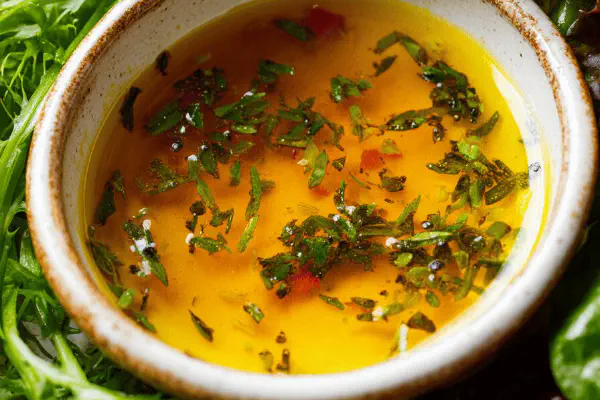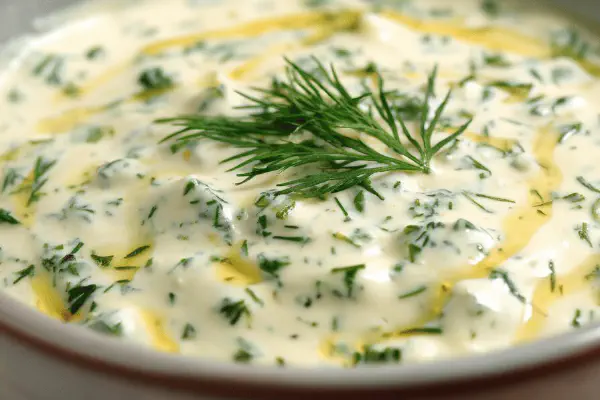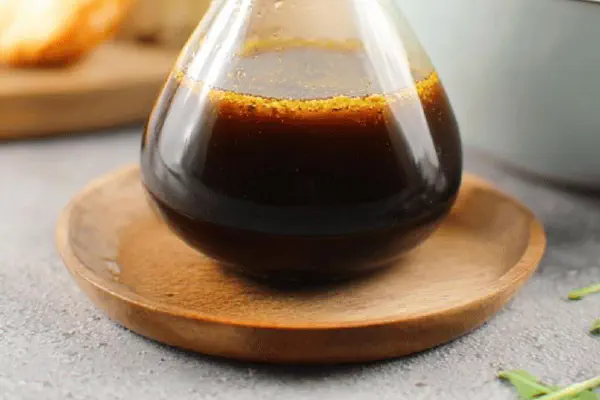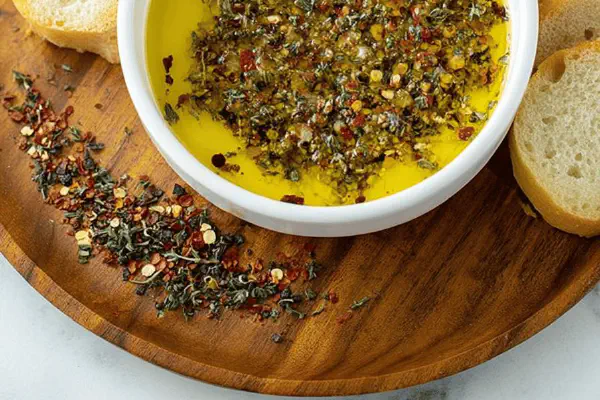Herb Vinaigrette Remix
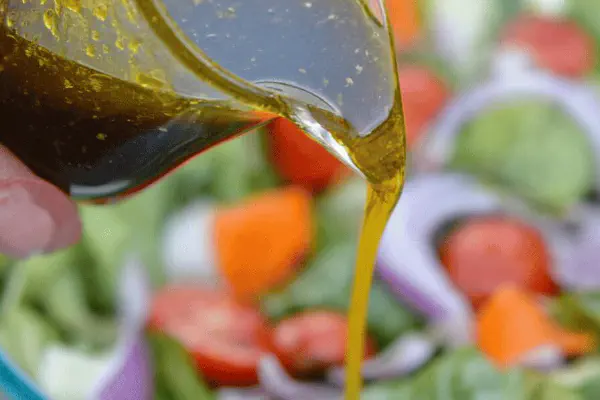
E
By Emma
Certified Culinary Professional
•
Recipe tested & approved
Shake together new mixes of herbs and oils for fresh, lively salads. Adjust herbs, swap vinegars, and twist oils for varied results. Learn to spot the right balance by eye and taste. Embrace the rough texture and vibrant aroma that changes as it melds. Freshness and timing key. Flavors brighten with a little patience, but don’t wait too long or it dulls. A flexible staple that adapts to what’s on hand – basil swapped for tarragon, apple cider vinegar swaps in for red. Dressing done when oily shimmer meets herb fleck. Pour generously but watch how those greens drink it up. Don’t fret if separation happens–just shake again and go.
Prep:
12 min
Cook:
0 min
Total:
12 min
Servings:
4 servings
#salad dressing
#vinaigrette
#herbs
#olive oil
#quick prep
#American cuisine
Already had my fair share of vinaigrettes, some too tart, others oily sludge. Learned from patience that letting flavors mingle beyond just shaking is key; herbs need a breath to open, oils must marry acids—not just toss ingredients blindly. Switched up basil to tarragon once, changed whole profile. Honey replaces sugar to add subtle complexity and mellow acidity without clashing. Mustard, never too much but always enough for a gentle bite, emulsifies and gives texture—watch it, more doesn’t mean better. Fresh herbs make or break—choose vibrant, smell ’em first, don’t rely on looks alone. Pour over robust greens so dressing doesn’t vanish immediately. An easy condiment but complicated when done right. Kitchen scent changes as it brightens, oils glisten with sheen of freshness. The sound of jar shaking, slap of vinaigrette hitting salad leaves, all signs you got it close to right.
Ingredients
- 3 tablespoons white wine vinegar
- 1 tablespoon fresh lemon juice
- 2 tablespoons honey
- 1/2 teaspoon Dijon mustard
- 1/2 cup extra virgin olive oil
- 1/4 cup fresh chopped tarragon leaves
- 1/4 cup fresh parsley, roughly napped
- 1 clove garlic, minced
- Salt and pepper to taste
About the ingredients
Swapping ingredients can save day when you don’t have exactly what recipe calls for. White wine vinegar gels with herbs nicely, but apple cider or champagne vinegar work well for different layers of flavor. Honey over sugar adds mouthfeel, subtle sweetness—not cloying but noticeable. Mustard provides that needed binding agent that holds oil and vinegar in unstable magic. Garlic crushed too coarsely becomes harsh; too finely minced and it disappears into blankness. Fresh tarragon replaced by dill or chervil—experiment according to what herb garden offers. Olive oil quality decides mouthfeel; go too cheap and oily bitterness ruins your work. Vegetable or avocado oils dull the brightness but still function if you have no choice. Salt and pepper aren’t to taste only but to balance acidity and sweetness. Always keep herbs fresh; old dried herbs flatten the texture and flavor completely.
Method
Preparation
- Start by mincing garlic finely. No big chunks. Garlic sharpness softens as it sits in acid.
- Roughly chop herbs—not too fine. Keep texture, color vibrance.
- In a medium jar with a lid, layer vinegars, lemon juice, honey, and Dijon mustard. Give a quick mix with a spoon to combine the wet flavors first.
- Add garlic, herbs. Pour olive oil on top but do not stir or shake yet.
- Seal tightly. Now, shake violently. Notice the thickening of the mixture, emulsification happening — oil and acid start binding but watch for oil separation after rest.
- Feel the consistency with spoon. Should be slightly thick but pourable, flecked with green bits, aroma the grassiness of fresh herbs and sharp citrus punch.
- Taste test. Adjust salt and pepper gradually—don’t overdo salt; it reveals more herb flavor rather than masks.
- Use immediately or refrigerate no longer than 2 days. Shake vigorously before every use. If herbs get dull or brown, toss and blend fresh batch.
- Pour on sturdy greens—arugula, kale. They hold up under the punch of lemon and mustard better than flimsy lettuces.
- Applications beyond salad: great drizzle on grilled fish or chicken. Also nice as quick marinate base.
- Keep an eye on vinegar substitutions. Apple cider vinegar gives earthier tone but less brightness than white wine.
- Olive oil: robust or mild? Choose based on how abrasive you want the mouthfeel.
- Make this in bigger batch for meal prep but don’t let it sit week-long or flavor goes flat.
Cooking tips
Combine acid and sweet components first to control sharpness before oil marine. Shaking jar is more than mixing—it emulsifies and blends volatile herb oils into the dressing. Observe the texture changes, sheen, and thickness. Herbs released color and fragrance as dressing rests for a few minutes; don’t rush. Taste frequently adjusting seasoning; acidic bite needs calming with some honey or citrus balancing. Garlic adds savory punch but must be minced just right to avoid zingy overkill. Use airtight container so flavors don’t escape or oxidize too fast. Chill if not using immediately but bring back to room temp and shake before use to re-emulsify. Pour over robust greens first—weak ones drown too soon. Dress at last moment to preserve crunch and freshness of salad. Storage time influences herb brightness—fresh always best. The minor variations on timing and shaking change the final texture and flavor, learn those cues by feel and smell more than stopwatch.
Chef's notes
- 💡 Garlic fine mince matters. Too big gives harsh raw zing; too tiny vanishes—balance. Acid tames sharpness slowly but needs time. Splash vinegar first, mix wet stuff well before oil tops. Oil goes last—do not stir then wait. Shake jar violently later. Emulsification feels thick, shiny. Look for green specs floating. Smell shifts grassy fresh to pungent citrus punch as it sits. Always taste for salt slow. Overdo salt hides herb brightness, under seasoning dulls. Timing is key: let rest few minutes but don’t drown herbs in waiting or flavor flattens fast.
- 💡 Herbs chopped coarsely > rough texture stays in mix. Fine chops risk muddy paste, lose vibrance visually and in mouthfeel. Tarragon swap? Dill, chervil work but change aroma sharply. Parsley rough chopped retains bite and green pop. Herbs older than a few days lose aroma, texture collapses fast. Mustard dose the binder—too little breaks emulsification, too much overwhelms heat and texture. Honey not sugar; adds subtle sweetness and smoothness. White wine vinegar gels best with herbs but apple cider vinegar adds earthier tone, less brightness—choose based on greens' toughness. Jar sealed tight before shaking or risk losing volatile fragrance.
- 💡 Shake technique matters. Violent shake emulsifies oil and acid. Sound changes from thin liquid slap to thick glide. Texture thickens, almost creamy but pourable. If mixture separates upon resting—normal. Shake again, regain shine. Do not stir after oil added before shaking; avoid breaking delicate mix. Taste test iterative—salt and pepper added bit by bit, each addition changes perception. Keep refrigerated no longer than 2 days; old vinaigrette tastes dull. Bring back to room temp before second use; cold oil stiffens flavor and texture. Robust sturdy greens like kale or arugula best for lemon-mustard punch; flimsy lettuces soak and lose crunch fast.
- 💡 Ingredient swaps flexible but affect final mouthfeel and aroma. Olive oil quality crucial—cheap oil can impart bitterness or dullness. Vegetable or avocado oils okay emergency subs but flavor shifts noticeably. Vinegar swaps change acid profile: champagne vinegar works for delicate brightness; apple cider gives deeper earth tone. Herb freshness non-negotiable; dry herb flatten texture and remove brightness. Keep herbs chilled and dry until use, avoid bruising. Salt balances acid and sweetness not just seasoning. Keep seasoning delicate or herb oils mask or mute. Adjust with lemon juice or honey to tweak acidity or sweetness on the fly.
- 💡 Batch size changes storage concerns. Larger batch for meal prep but don’t store beyond one week; flavor dulls, herbs brown. Make fresh if possible. Salad dressing best fresh—herbs open as flavor evolves, oils settle gently. Shake before each pour. Pour slowly over robust leaves, observe sheen, listen to splash sound on greens for texture. Dress right before serving; keep crunch in salad. Monitor separation visually and by smell—off aroma signals herb spoilage. Add fresh garlic each batch for spice lift. Be aware dressing thickens if refrigerated; warm jar before pour. Keep jar airtight to minimize oxidation.
Common questions
How finely to chop garlic?
Mince finely, not rough chunks. Big pieces bring harsh bite; too fine risks losing flavor. Acid tames garlic sharpness slowly. Freshness matters too.
Can I swap herbs?
Yes. Tarragon swaps well with dill or chervil but aroma shifts. Parsley key for brightness; dry herbs flatten flavor. Freshness is king here.
Why does dressing separate?
Separation normal due to oil and acid. Shake jar vigorously to re-emulsify. Don’t stir after oil added before shaking. If separation excessive, check mustard quantity or freshness.
How to store vinaigrette?
Airtight container best. Refrigerate up to 2 days max. Olive oil may thicken cold—bring to room temp, shake before use. Fresh herbs fade fast, so consider small batch sizes.
